
Sowing water? Yes, an ancestral solution

Hello, my friend
Thank you for reading our article and we invite you to visit our blog. Knowing more about the role that water plays in our planet is necessary.
Here we explain why it is good to sow water
Although the technique of “sowing water” may seem incredible, it is indeed possible to obtain water in this way and it arises from the need to seek innovative and sustainable solutions for the management of this vital resource.
With this article we will explore why it is crucial to plant water, how this practice is carried out, where we can implement it, who should lead these efforts and the effectiveness of this action in the preservation of water as a water resource.
Why plant water?
Planting water is essential because freshwater is a limited and vital resource for life on our planet. With population growth and the impact of climate change, we face increasing challenges to ensure an adequate supply of fresh water and maintain healthy aquatic ecosystems.
Sowing water means taking proactive measures to conserve, protect and restore water ecosystems, thus ensuring a sustainable water supply for present and future generations.
What are the benefits of water seeding?
Apart from being evident that the planting of water generates sources of this water resource, it also brings multiple benefits such as:
Improves water infiltration into the soil: Reduces surface run off and erosion, allowing water to penetrate the soil and recharge subway aquifers.
Improves water quality: Water stored in the soil is filtered naturally, removing impurities and contaminants.
Promotes biodiversity: Attracts a variety of water-dependent plants and animals, creating a more diverse and healthy ecosystem.
Combats climate change: Helps mitigate the effects of climate change by reducing desertification and increasing carbon sequestration.
YOU MAY BE INTERESTED IN: The thorny broom: Between ecosystems and water

Is planting water effective?
Water seeding is an effective technique to improve water availability and quality, and has been demonstrated in different studies and projects around the world, especially in arid and semi-arid zones, as it seeks to effectively retain water in soils.
Where can I plant water?
Water seeding can be carried out in a variety of environments, but it is mainly done in any area where water scarcity is present, especially in arid and semi-arid areas. It is important to consider the characteristics of the terrain, the slope of the soil and the availability of rainwater to determine the ideal location.
How is water planted?
Planting water involves a series of steps :
1. Select the site: An area with a moderate slope and permeable soil should be chosen, where the water harvesting infrastructure will be built.
2. Build a trench or well: Once the site is found, it must be excavated to create a trench or well with the desired depth and dimensions. The shape and size may vary depending on the characteristics of the land and the amount of water to be collected.
3. Backfill the interior: To promote safe and effective water uptake, natural materials such as gravel, sand and stones should be used. These materials are permeable and allow water to flow into the well while filtering out solid particles.
4. Covering the surface: The soil surface is covered with mulch or organic material, such as dry leaves or straw, to help conserve soil moisture and reduce evaporation.
Who should plant water?
Sowing water is a shared responsibility that involves different actors such as:
Local communities: Communities can implement water planting on their own land to improve their access to this vital resource.
Governments: Governments can support the implementation of water seeding through training programs, technical assistance and financing.
Private sector: The private sector can invest in research, development and implementation of innovative technologies for water seeding.
Sowing is an ancestral practice that must be carried out in a responsible and sustainable manner, using appropriate materials and avoiding any action that may damage the ecosystem. With this technique, we will help ecosystems and biodiversity, and also ensure a secure water supply for future generations.




